Menus
- F for disguise
- Technical basis of the CB 650 F
- Row fours purr like sewing machines
- Yamaha XJ6 Diversion F one shot glass more displacement
- Honda CBR 650 F with 214 kg the lightest
- Suzuki GSX 650 F with the best wind protection
- Technical data Honda CBR 650 F
- Technical data Suzuki GSX 650 F
- Technical data Yamaha Diversion F
- Performance measurement
- Scoring and conclusion
- engine
- landing gear
- everyday life
- security
- costs
- Overall rating and conclusion
- Price comparison of the Honda CBR 650 F, the Suzuki GSX 650 F and the Yamaha XJ6 Diversion F.
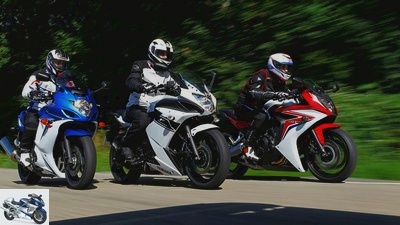
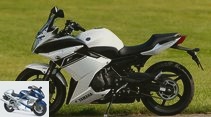
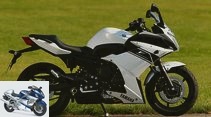
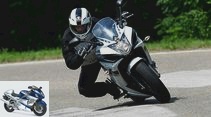
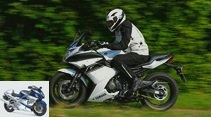
46 photos

1/46
The Suzuki as a solid all-rounder, the Yamaha as a lively fun bike. Honda is changing the CB 650 F with the casing, on the other hand, transforming the naked bike into a mid-range athlete.
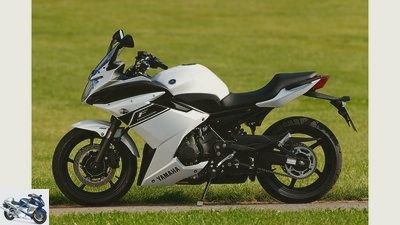
2/46
By the way, the technology of the XJ6 performed extremely well in the MOTORRAD endurance test.
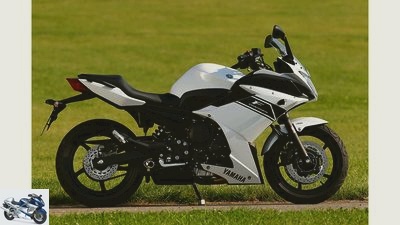
3/46
Sleek: The XJ6 Diversion F is clearly related to its naked sister. However: Only 15 percent of all XJ6 are sold with full casing.
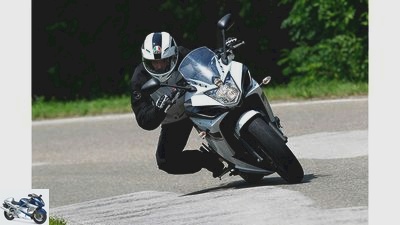
4/46
Showcase model: The fact that the Diversion F was presented just two years after the Suzuki is hard to believe given the successful look of the Yamaha.
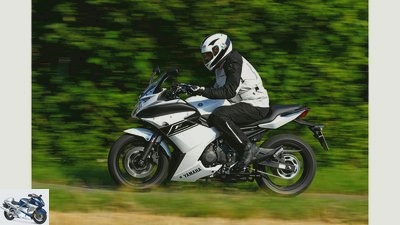
5/46
The Yamaha XJ6 Diversion F.
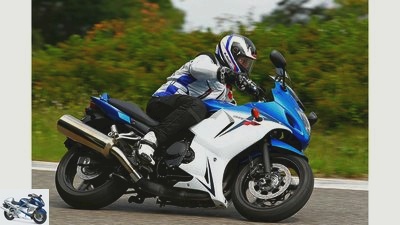
6/46
However: 30 kilos overweight and an inhomogeneous suspension setup cost sympathy.
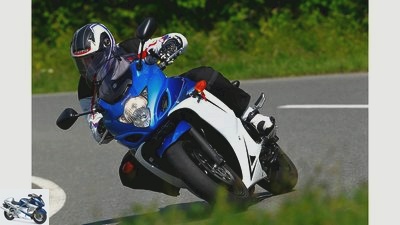
7/46
The engine is even superior to that of the Honda in the medium speed range, and its touring suitability is impressive.
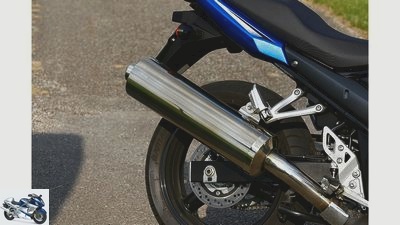
8/46
Like the other models, the Suzuki GSX 650 F is equipped with ABS.
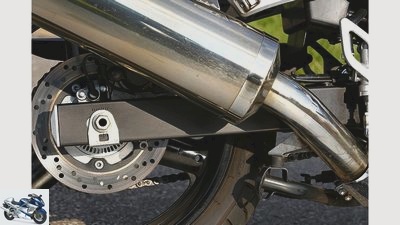
9/46
The exhaust of the Suzuki GSX 650 F.
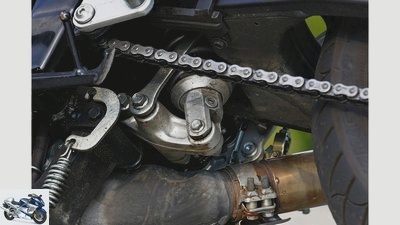
10/46
The chain drive of the Suzuki GSX 650 F.
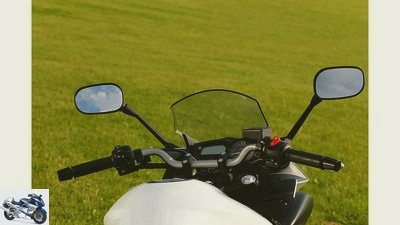
11/46
Half-height handlebars, sufficient disc – the Yamaha offers the middle ground between the Honda and the Suzuki.
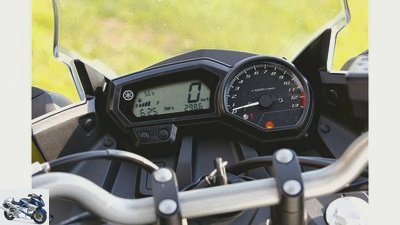
12/46
And again, analog: less dominant rev counter and decent digital display. But only with basic information.

13/46
The Yamaha XJ6 Diversion F has a total output of 78 hp.
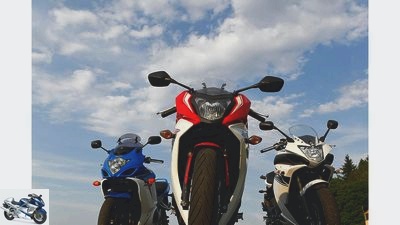
14/46
With their F models, Suzuki and Yamaha only rely on the orientation of the respective base machines, but retain their conceptual orientation.
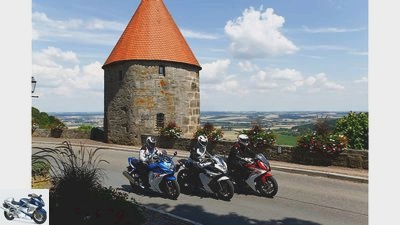
15/46
Beyond the ice cream parlor: Others are responsible for the show – the three mid-range four-cylinder units are excellent for everything else.
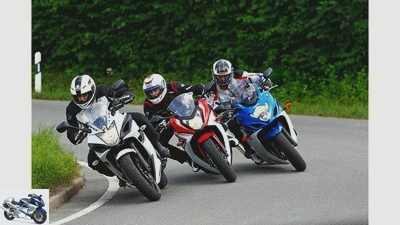
16/46
Frontal attack: This view shows how narrow the mid-range four-cylinder engines are. The Suzuki (right) looks the bulkiest, the Honda (middle) the slimmest.

17/46
This has advantages (good suspension comfort, agile handling), but also disadvantages: the tourist aspect and pillion suitability are clearly neglected with the sleek styled Yamaha.
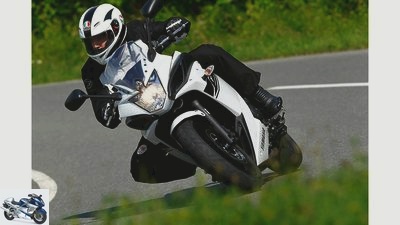
18/46
Conceptually, the Diversion F remains very close to its naked bike sister XJ6.
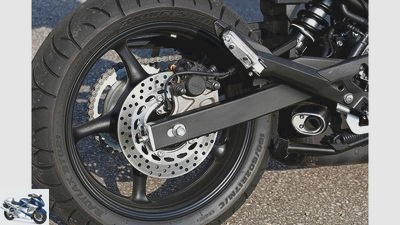
19/46
Cheap solutions swing arm and chain tensioner. The missing redirection of the shock absorber creates space for the exhaust.
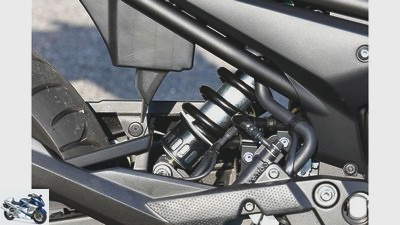
20/46
The suspension of the Yamaha XJ6 Diversion F.
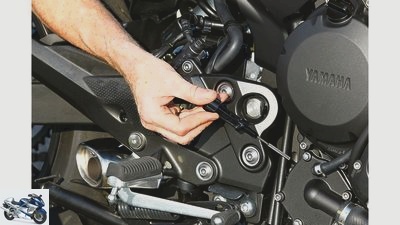
21/46
Oil check on the Yamaha XJ6 Diversion F..
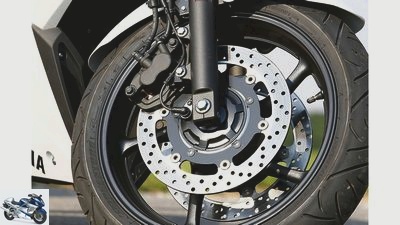
22/46
Smaller 298 mm brake discs in the XJ6 (Honda: 320 mm, Suzuki 310 mm). The wheels look straightforward.
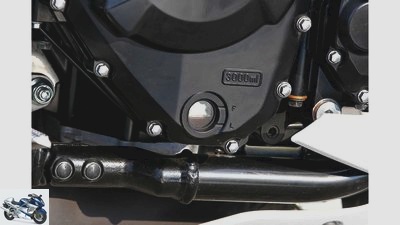
23/46
The Suzuki GSX 650 F.
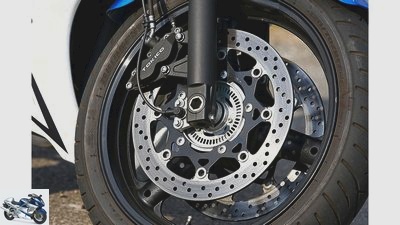
24/46
The GSX 650 F is the only one of the trio to use a fixed calliper brake. The cast wheels look a bit coarse.
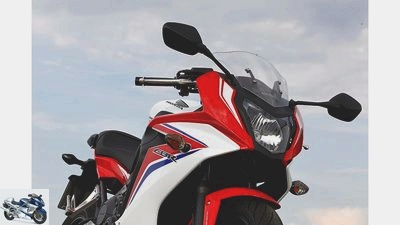
25/46
The Honda CBR 650 F has a total of 87 hp.
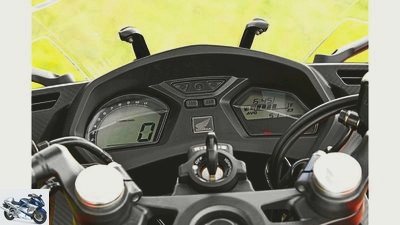
26/46
Modern times: tidy cockpit, good readability – and a remaining range display.
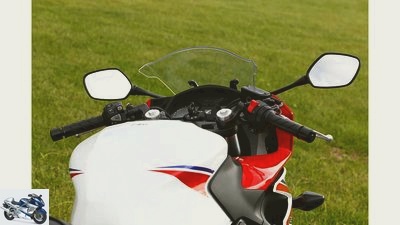
27/46
The tank of the Honda CBR 650 F has a total of 17.3 liters.
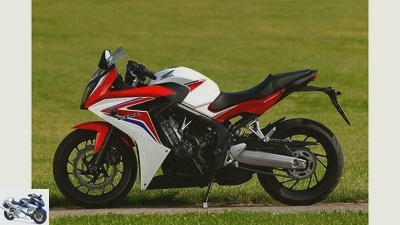
28/46
The new Honda CBR 650 F may bring momentum to the starving category at just the right time. The technical basis is taken over by the new one from the basic bike.
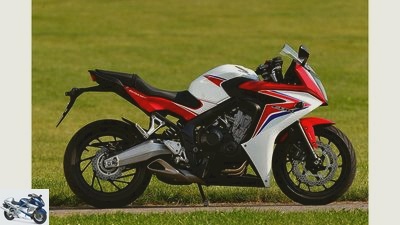
29/46
What a difference: Despite a few changes (fairing, stub handlebars), the look of the CBR 650 F is hardly reminiscent of the bare basic CB 650 F bike.
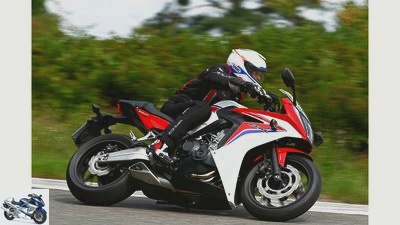
30/46
Frontman: The clip-ons move the driver’s driving posture forward and emphasize the sporty orientation of the CBR.
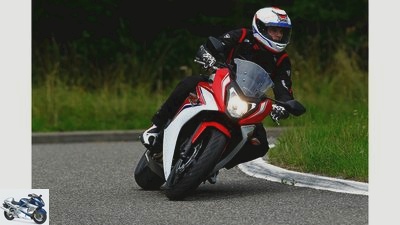
31/46
The Honda CBR 650 F.
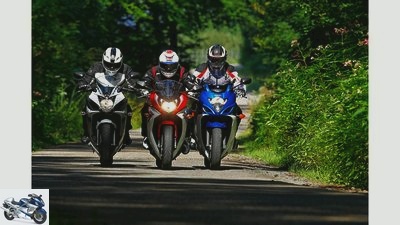
32/46
So it could all be so nice for the Honda CBR 650 F, the Suzuki GSX 650 F and the Yamaha XJ6 Diversion F. But it is not. Because when it comes to engine concepts, two- or three-cylinder engines are more in trend in the mid-size class, and naked bikes are currently more popular than fully clad bikes.
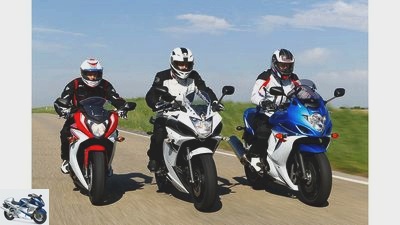
33/46
Smooth-running four-cylinder engines are stuck between their frame tubes, full fairings defy the weather, and the wallet is not overburdened with prices of around 8,000 euros.
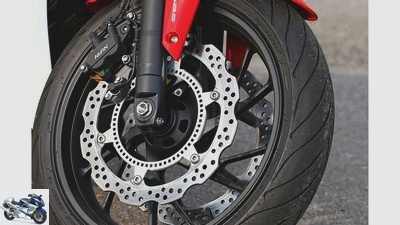
34/46
The modern wave brake disc of the CBR looks great, just like the filigree cast wheels.
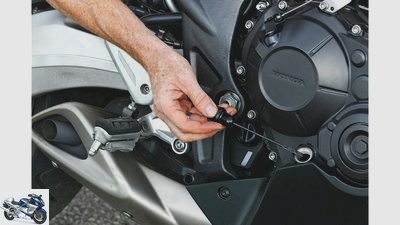
35/46
Oil check on the Honda CBR 650 F.
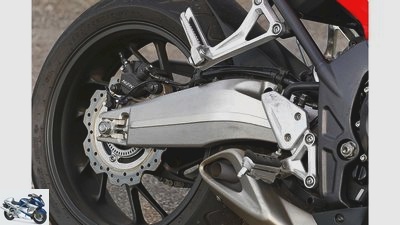
36/46
The aluminum swingarm demonstrates the generally high quality and superior processing of the CBR.
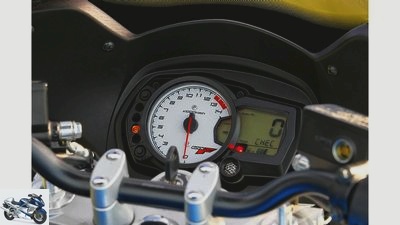
37/46
Analog also has something: no frills tachometer, plus a gear indicator and also a remaining range indicator.
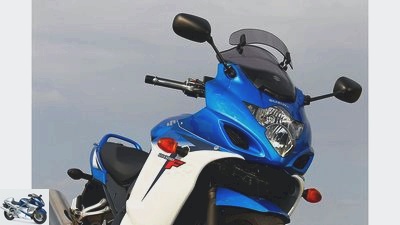
38/46
Overall, the Suzuki GSX 650 F weighs 248 kg on the scales.
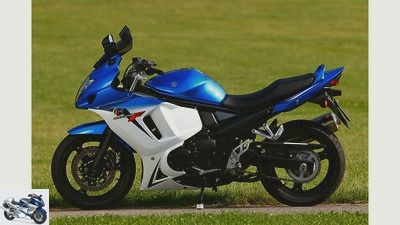
39/46
The Suzuki GSX 650 F has an output of 86 hp.
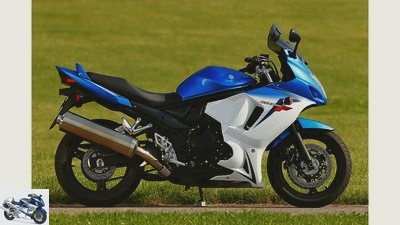
40/46
Quite the classic: The GSX 650 F presented in 2009 shares the chassis and peripherals with the 1250 Bandit – the weight (248 kg) and the powerful silencer too.
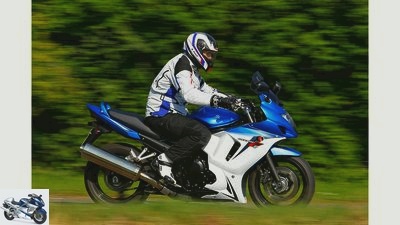
41/46
With moderation to the goal: With the longest wheelbase and the greatest overrun of the test field, the Suzuki calmly draws its lines. The sovereign appearance definitely has its charm.
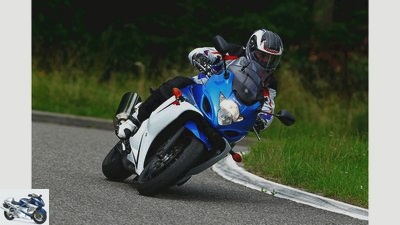
42/46
The Suzuki GSX 650 F.
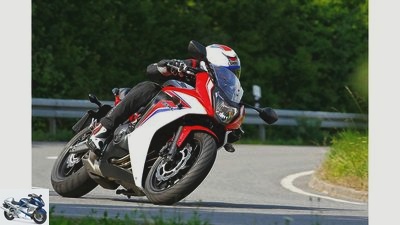
43/46
Decent workmanship, great performance, low consumption – this is what the Honda CBR 650 F can do.
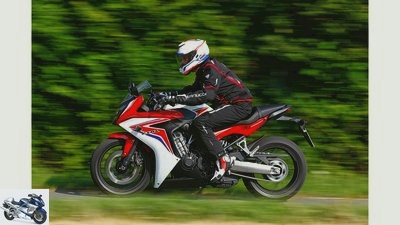
44/46
The hour of the Honda strikes only in the last third of the speed. There, the CBR throws the advantages of its short-stroke concept into the scales, cheers noticeably more lively until shortly before the 12,000 mark than the Suzuki and ultimately underlines its sporting orientation, which is already indicated by the seating position.
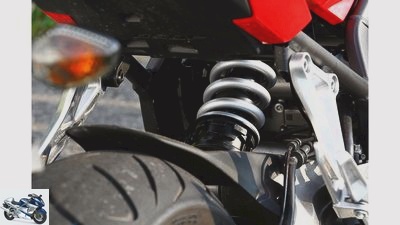
45/46
The suspension of the Honda CBR 650 F.
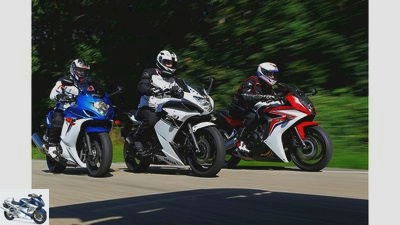
46/46
Actually, mid-range four-cylinder could be among the stars of the industry.
Honda CBR 650 F, Suzuki GSX 650 F, Yamaha XJ6 Diversion F in the test
F for disguise
Don’t worry, not everything fell victim to the spelling reform. In this trio, the F behind the model names probably stands for the English word fairing (disguise). With the CBR 650 F, Honda brings a breath of fresh air to the segment of the interconnected middle class with Fier, sorry four-cylinder engines, which has so far only been occupied by the Suzuki GSX 650 F and the Yamaha XJ6 Diversion F.
They could actually be among the stars in the industry. Smooth-running four-cylinder engines are stuck between their frame tubes, full fairings defy the weather, and the wallet is not overburdened with prices of around 8,000 euros. So it could all be so nice for the Honda CBR 650 F, the Suzuki GSX 650 F and the Yamaha XJ6 Diversion F. But it is not. Because when it comes to engine concepts, two- or three-cylinder engines are more in trend in the mid-size class, and naked bikes are currently more popular than fully clad bikes.
Buy complete article
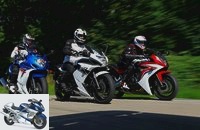
Honda CBR 650 F, Suzuki GSX 650 F, Yamaha XJ6 Diversion F in the test
F for disguise
XJ6 Diversion F has been upgraded.
Technical basis of the CB 650 F
In this respect, the new Honda CBR 650 F may bring momentum to the starving category at just the right time. The new model takes over the technical basis from its bare sister, the CB 650 F, which was also only introduced this year. The key differences: First, the full fairing. Second, two handlebar stubs mounted above the triple clamps replace the one-piece, upward-drawn handlebars of the CB. Third, harder spring rates make the fork and strut tighter. And fourthly, this effort adds up to 600 euros. The Honda CBR 650 F costs 8555 euros (including ancillary costs).
This makes her the most expensive of the trio. The Yamaha XJ6 Diversion F (8125 euros) is around 400 euros cheaper. After the recent price cut of almost 1400 euros, the Suzuki GSX 650 F (7160 euros) is entering the race at the competitive price. Got up. With a seat height of 800 millimeters (Suzuki and Yamaha) and 810 millimeters (Honda), the three of them are user-friendly as soon as they get to know each other. Small cause, big effect with the Honda: The handlebars tilt the upper body of the CBF driver forward, making the upright riding posture on the sister model forgotten. Sports tourers instead of naked bikes. Not that this ergonomics is inconvenient. After a few hours in the saddle, it is particularly useful if the arms also support part of the body weight.
Nevertheless, the Honda CBR 650 F has undergone a conceptual change. The handlebars of the Suzuki GSX 650 F greedily stretch out towards the pilot, letting him rest upright on the well-padded bench. In general, the GSX gives this group the greatest sense of space. Paneling, knee joint, handlebars – everything is a tad wider and more voluminous than with the two colleagues. No wonder, after all, the 650er shares both chassis and attachments with the 1250er Bandit. But: while taller pilots enjoy the freedom of movement, drivers under 1.80 meters involuntarily have to stretch over the relatively long tank to the steering head. Which is why they will feel most comfortable on the Yamaha. The overall package of the Yamaha XJ6 Diversion F appears more compact, the narrow handlebar with its crank hits the middle between the Honda and the Suzuki.
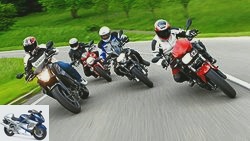
Naked bike
Honda CB 650 F, Ducati Monster 796, Aprilia SL 750 Shiver, BMW F 800 R.
90 hp Nakeds in a comparison test
read more

Naked bike
Yamaha MT-07 and Kawasaki ER-6n in comparison test
Star ensemble of the middle class
read more
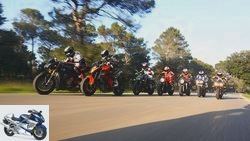
Naked bike
7 power naked bikes in a comparison test
Every man for himself
read more
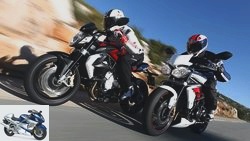
Naked bike
Comparison test: Naked bikes from MV Agusta and Triumph
MV Agusta Brutale 800 and Triumph Street Triple R in comparison test
read more
Row fours purr like sewing machines
Press the button. Departure. No uneven engine running, no cold start problems. Chain whipping or jerking certainly not at all. What do these four-cylinder units think of the zeitgeist? A trend that dismisses its linear character as boring? They want to be perfect, not to be naked. And don’t do that either. Just moving off: idle, release the clutch, drive away? No problem. The Honda CBR 650 F even has an increase in idle gas when the clutch is engaged – although this is hardly noticeable in practice. Perhaps because it is precisely her, whose clutch is more acute than the rest. The lever is easy to pull for this. Lighter than that of the Yamaha XJ6 Diversion F and also that of the Suzuki GSX 650 F, which is the only one that offers hydraulic actuation – and a lever that can be adjusted in reach.
Like the sewing machines, the four in a row purr to themselves. Logically, no one expects brute pressure from the low revs from 600 series engines. And yet they are doing better than expected in this particular respect.
It is this silky smooth running of the engine that occasionally makes the driver forget to shift gears, the quadruples drop to 2000 revs and then openly accelerate. Again, no swallowing, no delayed throttle response, just well controllable and cultivated propulsion. The venerable Suzuki engine is the most vicious in comparison. With its 2.7 millimeter longer stroke, it is a tad superior to the Honda engine, which has almost the same displacement with 649 cm³, especially in the practice-relevant medium speed range. Not only does the Suzuki propellant pack a little stronger, it also sets the tone on the test bench up to 8000 tours. When swinging country roads, the small torque advantage is definitely noticeable, making the Suzuki GSX 650 F always a little more powerful at the cornering point and thus making it appear more confident.
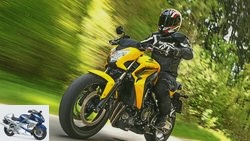
Naked bike
Honda CB 650 F in the top test
Just ride a motorcycle
read more
Yamaha XJ6 Diversion F one shot glass more displacement
The hour of the Honda CBR 650 F only strikes in the last third of the speed. There, the CBR throws the advantages of its short-stroke concept into the scales, cheers noticeably more lively until shortly before the 12,000 mark than the Suzuki GSX 650 F and ultimately underlines its sporty orientation, which is already indicated by the seating position. The Yamaha XJ6 Diversion F documents what a shot glass of combustion chamber can do in this class. Just 50 cm³ of displacement separate the 600 cm³ engine of the XJ6 from its colleagues. It feels like a lot more. Whereby it is not the lower peak power measured with 74 PS (Honda: 87 PS, Suzuki: 85 PS) that leaves the Yamaha behind, but above all the noticeably lower torque over the entire speed range. By the way: instead of full power, all three are also available in the A2 driver’s license version, throttled to 48 hp.
Back to the Yamaha XJ6 Diversion F. Again and again you find yourself keeping the XJ at revs, simply turning down the gear between turns instead of shifting up. The fact that the rev limiter intervenes 700 tours earlier at 11,200 rpm than on the Honda CBR 650 F and Suzuki GSX 650 F does not bother us. Because while the trio behaves acoustically pleasantly socially acceptable at moderate speeds, it blares obtrusively loudly from the silencers in the five-digit speed range. Those who want to spare residents and their own nerves usually voluntarily switch up much earlier.
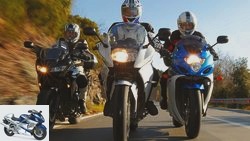
Tourer
The all-rounders from BMW, Honda and Suzuki in a comparison test
BMW F 800 GT against Honda CBF 1000 and Suzuki GSX 650 F
read more
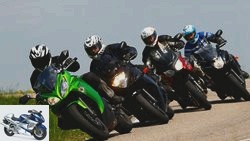
motorcycles
Comparison of mid-range all-rounders
Middle class bikes from Yamaha, Kawasaki, Suzuki and Honda
read more
Honda CBR 650 F with 214 kg the lightest
And meanwhile concentrates on what these mid-range bikes can do best: swinging effortlessly and with vigor along roads with little traffic. A terrain where the Honda CBR 650 F comes to life. The aforementioned front-wheel-oriented seating position lets the front literally stick to the ground and the Honda steers precisely. The fact that the CBR does not even have to pay tribute to its wide 180 mm rear tire – the Suzuki GSX 650 F and Yamaha XJ6 Diversion F roll on 160 mm tires – speaks for the carefully coordinated chassis geometry and a suitable tire choice, the rather antiquated Dunlop D 222 for Despite. And of course for the trio’s lowest weight at 214 kilograms.
Whereby the Yamaha does not spoil. The XJ turns nimbly around the corners, despite its 221 kilograms with its higher handlebars and a gathered seating position, it can be easily thrown from one lean angle to the next, and ultimately even puts the Honda in its place. The Suzuki anyway. Because the GSX can never hide its stately 249 kilograms. Neither did the largest wheelbase and the longest caster in the test field. It therefore moves its course cleanly, but comparatively slowly, conveying trust, but little agility.
And their chassis could also be a little more homogeneous. Even with the lowest spring preload and rebound damping opened by two out of three turns, the hindquarters are quite tight. The front fork, on the other hand, remains relatively soft even with maximum spring preload. After all: With these adjustment options and a lever assembly, the Suzuki stands out from the rest of the duo. There, non-adjustable forks and simple, directly hinged shock absorbers that can only be adjusted in the spring base are evidence of budgetary discipline. The latter, however, not only for reasons of cost. Only the shock absorber mounted directly on the swing arm creates space for the voluminous underfloor collector with stubby exhaust on the CBR and the XJ, which protects the look of the rear from a powerful silencer like the Suzuki.
Beyond the ice cream parlor: Others are responsible for the show – the three mid-range four-cylinder units are excellent for everything else.
The economy solution does little to detract from driving comfort. At least not with the Yamaha XJ6 Diversion F. Equipped with soft springs and dampened appropriately, the XJ6 glides casually over grain asphalt. In contrast to the Honda CBR 650 F. Because the sporty touch of the CBR is also reflected in its suspension tuning. The tightly dampened shock absorber keeps the rear well under control during the ambitious sprint at the exit of a curve, the fork does not lock up even when braking heavily. However: the CBR irones away larger potholes or asphalt faults much less sensitively than the competition.
In passenger operations, however, it benefits from the tight alignment and hardly sways on bumpy slopes. The Suzuki GSX 650 F also stands out well in two-person use thanks to its firm hindquarters, and with the progressive deflection it offers even greater suspension reserves at least at the rear. The Yamaha XJ6 Diversion F hits them relatively quickly. Despite the raised spring base at the rear, the Diversion F balances itself with additional staff through the spring travel, then appears underdamped, restless and nervous. At least it sits neatly in the back seat. Sensible upholstery, open knee angles and handy grab bars offer more comfort than the sporty look suggests. Just like the similarly designed Honda passenger seat, where only the slightly less ergonomic recessed grip bothers. The Suzuki offers the widest seat and the best support. However, the voluminous silencer forces the passenger footrests to be in a high position and thus a narrow knee angle. Praiseworthy: Suzuki mounts the driver’s footrests on rubber-mounted and thus vibration-damped plates, Yamaha even does this favor for the passenger.

motorcycles
Endurance test final balance of the Yamaha XJ6 Diversion
Disassembled after 50,000 kilometers
read more
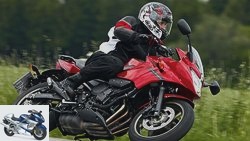
motorcycles
Endurance test interim balance: Yamaha XJ6 Diversion
Yamaha’s 600 all-rounder after 30,000 kilometers
read more
All used offers: Yamaha XJ 600 S Diversion
Suzuki GSX 650 F with the best wind protection
Turn right onto the autobahn. With the naked relatives one would have ignored the high-speed strip at all costs. But so, behind the protective plastic cover – let’s see what works. The Honda CBR 650 F already sets itself apart on the threading track. At first hesitant, then more and more dominant. The CBR runs a measured 218 km / h on the open road, a proud 23 km / h faster than the factory specification. Impressive, even if the engine has to work hard in the long-geared last gear.
The pair of pursuers lost the connection from around 170 km / h. First the Yamaha XJ6 Diversion F (top speed: 205 km / h), a long time later the Suzuki GSX 650 F (top speed: 211 km / h). Whereby the pilot on the GSX remains undisturbed by the hurricane behind the wide fairing and the comparatively opulent windshield including Varioscreen attachment (120 euros) even at intercity speed and in an upright position. Meanwhile, the storm behind the delicate Yamaha windshield has long been pulling hard on the helmet and shoulders. On the Honda, the driver – once again a real athlete – has to fold up tightly behind the tightly cut fairing for adequate wind protection. If you don’t want that, you have to invest 125 euros in the 35 millimeter higher retrofit disc from the Honda range of accessories.
He can save the money for this by refueling. With 3.9 liters per 100 kilometers, the Honda will later be modest after the consumption round and thus also demonstrate the technical development of recent years. The Suzuki engine, the oldest of the four-cylinder ranks, will need 4.4 liters, while the younger Yamaha propellant will need 4.2 liters. A development that is also reflected in the inspection intervals. There are 12,000 kilometers between the technical checks of the Honda CBR 650 F, 10,000 kilometers for the Yamaha XJ6 Diversion F, while for the Suzuki GSX 650 F the long outdated and technically unnecessary 6000 cycle still applies. At least a main stand can be ordered for chain service or luggage loading on the Suzuki for little money (130 euros); the Yamaha even has it as standard. There is no room for this on the sporty Honda.
Which is ultimately just one more aspect that diversifies the overall view of the trio. Because Suzuki and Yamaha only saddle up with their F models on the orientation of the respective base machines, but retain their conceptual orientation. The Suzuki as a solid all-rounder, the Yamaha as a lively fun bike. Honda is changing the Honda CB 650 F with the casing, on the other hand, transforming the naked bike into a mid-range athlete. However, it does not owe the test victory to this gender reassignment, but to the sum of good workmanship, decent brakes, brisk performance, moderate consumption, in short: its more modern technology.
Technical data Honda CBR 650 F
What a difference: Despite a few changes (fairing, stub handlebars), the look of the CBR 650 F is hardly reminiscent of the bare basic CB 650 F bike.
engine
| design type |
Four-cylinder four-stroke- In-line engine |
| injection | 4 x Ø 32 mm |
| coupling |
Multi-panes- Oil bath clutch |
| Bore x stroke | 67.0 x 46.0 mm |
| Displacement | 649 cc |
| compression | 11.4: 1 |
| power |
64.0 kW (87 hp) at 11000 rpm |
| Torque | 63 Nm at 8000 rpm |
landing gear
| frame |
Bridge frame from steel |
| fork | Telescopic fork, Ø 41 mm |
| Brakes front / rear | Ø 320/240 mm |
| Assistance systems | SECTION |
| bikes | 3.50 x 17; 5.50 x 17 |
| tires |
120/70 ZR 17; 180/55 ZR 17 |
| Tires |
Dunlop Sportmaxx D 222 “M” |
mass and weight
| wheelbase | 1450 mm |
| Steering head angle | 64.5 degrees |
| trailing | 101 mm |
| Front / rear suspension travel | 120/128 mm |
| Seat height * | 810 mm |
| Weight with full tank * | 214 kg |
| Payload * | 185 kg |
| Tank capacity / reserve | 17.3 liters |
| Service intervals | 12,000 km |
| price | 8290 euros |
| Price test motorcycle | 8290 euros |
| Additional costs | 265 euros |
| * MOTORCYCLE measurements | |
MOTORCYCLE readings
| Top speed | 218 (195) * km / h |
| acceleration 0-100 km / h 0-140 km / h 0-200 km / h |
3.8 sec 6.5 sec 17.1 sec |
| Draft 60-100 km / h 100-140 km / h 140-180 km / h |
4.8 sec 5.7 sec 7.1 sec |
| Consumption country road / 100 km | 3.9 liters |
| Reach country road | 444 km |
| * Manufacturer information | |
Technical data Suzuki GSX 650 F
Quite the classic: The GSX 650 F presented in 2009 shares the chassis and peripherals with the 1250 Bandit – the weight (248 kg) and the powerful silencer too.
engine
| design type | Four-cylinder four-stroke- In-line engine |
| injection |
4 x Ø 36 mm |
| coupling | Multi-panes- Oil bath clutch |
| Bore x stroke |
65.5 x 48.7 mm |
| Displacement |
656 cc |
| compression |
11.5: 1 |
| power | 63.0 kW (86 PS) at 10500 rpm |
| Torque |
62 Nm at 8900 rpm |
landing gear
| frame |
Double loop frame made of steel |
| fork |
Telescopic fork, Ø 41 mm |
| Brakes front / rear |
Ø 310/240 mm |
| Assistance systems |
SECTION |
| bikes | 3.50 x 17; 5.00 x 17 |
| tires | 120/70 ZR 17; 160/60 ZR 17 |
| Tires |
Bridgestone, front BT 011 “G”, rear BT 020 “G” |
mass and weight
| wheelbase |
1470 mm |
| Steering head angle |
64.0 degrees |
| trailing |
108 mm |
| Front / rear suspension travel |
130/128 mm |
| Seat height * |
800 mm |
| Weight with full tank * |
248 kg |
| Payload * |
207 kg |
| Tank capacity / reserve |
19.0 liters |
| Service intervals |
6000 km |
| price | 6990 euros (Best price promotion) |
| Price test motorcycle |
7240 Euro² |
| Additional costs |
170 euros |
| * MOTORCYCLE measurements; ² including vario touring screen (120 euros) and main stand (130 euros) |
|
MOTORCYCLE readings
| Top speed | 211 (205) * km / h |
| acceleration 0-100 km / h 0-140 km / h 0-200 km / h |
4.1 sec 7.4 sec 20.5 sec |
| Draft 60-100 km / h 100-140 km / h 140-180 km / h |
4.8 sec 5.4 sec 6.8 sec |
| Consumption country road / 100 km |
4.4 liters |
| Reach country road |
432 km |
| * Manufacturer information | |
Technical data Yamaha Diversion F
Sleek: The XJ6 Diversion F is clearly related to its naked sister. However: Only 15 percent of all XJ6 are sold with full casing.
engine
| design type | Four-cylinder four-stroke- In-line engine |
| injection |
4 x Ø 32 mm |
| coupling | Multi-panes- Oil bath clutch |
| Bore x stroke |
65.5 x 44.5 mm |
| Displacement |
600 cc |
| compression |
12.2: 1 |
| power | 57.0 kW (78 hp) at 10,000 rpm |
| Torque |
60 Nm at 8500 rpm |
landing gear
| frame | Bridge frame from steel |
| fork |
Telescopic fork, Ø 41 mm |
| Brakes front / rear |
Ø 298/245 mm |
| Assistance systems |
SECTION |
| bikes | 3.50 x 17; 4.50 x 17 |
| tires | 120/70 ZR 17; 160/60 ZR 17 |
| Tires | Bridgestone BT 021 “G” |
mass and weight
| wheelbase |
1440 mm |
| Steering head angle |
64.0 degrees |
| trailing |
104 mm |
| Front / rear suspension travel |
130/130 mm |
| Seat height * |
800 mm |
| Weight with full tank * |
221 kg |
| Payload * |
179 kg |
| Tank capacity / reserve |
17.0 liters |
| Service intervals |
10000 km |
| price |
7,995 euros |
| Price test motorcycle |
7,995 euros |
| Additional costs |
180 euros |
| * MOTORCYCLE measurements | |
MOTORCYCLE readings
| Top speed | 205 (205) * km / h |
| acceleration 0-100 km / h 0-140 km / h 0-200 km / h |
4.1 sec 7.5 sec 27.3 sec |
| Draft 60-100 km / h 100-140 km / h 140-180 km / h |
5.2 sec 5.6 sec 6.9 sec |
| Consumption country road / 100 km |
4.2 liters |
| Reach country road |
405 km |
| * Manufacturer information | |
Performance measurement
BILLION
The performance measurement of the Honda, Suzuki and Yamaha.
Even if the power and torque curves of the Honda CBR 650 F and the Suzuki GSX 650 F are relatively close, the difference, which at first glance appears to be marginal, can be clearly felt in practice. The Suzuki four-cylinder is a tad superior to the short-stroke Honda engine up to 8000 rpm, pushes noticeably more powerfully on the country road and hangs more confidently on the gas. The Honda’s pronounced revving pleasure, which is also manifested in the performance diagram from 10,000 rpm, is rarely used in everyday life. The aggressive screeching of the four-cylinder at high engine speeds stresses residents and your own nerves. In this comparison, the Yamaha (600 cm³) pays tribute to its displacement disadvantage (600 instead of 650 cm³). The Yamaha XJ6 Diversion F not only loses at least 10 HP of peak power compared to the next stronger machine, it is also below the competition in terms of torque throughout the entire speed range. On the country road there is a tendency to keep the XJ at speed.
Scoring and conclusion
The Suzuki GSX 650 F as a solid all-rounder, the Yamaha XJ6 Diversion F as a lively fun bike. Honda is changing the CB 650 F with the casing, on the other hand, transforming the naked bike into a mid-range athlete.
engine
| Maximum Score |
Honda CBR 650 F |
Suzuki GSX 650 F |
Yamaha XJ6 Diversion F |
|
| Draft | 40 | 22nd | 22nd | 21st |
| acceleration | 40 | 22nd | 17th | 17th |
| Top speed * | 30th | 16 | 15th | 14th |
| Engine characteristics | 30th | 18th | 17th | 15th |
| Responsiveness | 20th | 14th | 13 | 14th |
| Load change | 20th | 13 | 13 | 13 |
| Smoothness | 20th | 13 | 12th | 13 |
| coupling | 10 | 8th | 7th | 8th |
| circuit | 20th | 12th | 12th | 12th |
| Gear ratio | 10 | 7th | 8th | 8th |
| Start | 10 | 8th | 8th | 8th |
| total | 250 | 153 | 144 | 143 |
| * Evaluation basis: MOTORCYCLE measurement | ||||
In terms of performance, the Honda outshines the competition, especially in the higher speed range. The top speed of 218 km / h is at least 23 km / h above the manufacturer’s specification of 195 km / h. Also a consequence of the somewhat too long translation. The point gap between the Suzuki and the Yamaha does not reveal the real balance of power. The GSX drive pushes forward much more confidently than the 50 cm³ smaller XJ propellant.
Winner engine: Honda CBR 650 F
landing gear
| Maximum Score |
Honda CBR 650 F |
Suzuki GSX 650 F |
Yamaha XJ6 Diversion F |
|
| Handiness | 40 | 27 | 25th | 28 |
| Stability in turns | 40 | 26th | 24 | 23 |
| Steering behavior | 40 | 27 | 26th | 27 |
| feedback | 10 | 8th | 6th | 7th |
| Inclined position | 20th | 16 | 15th | 15th |
| Straight-line stability | 20th | 15th | 15th | 14th |
| Suspension tuning in front | 20th | 12th | 11 | 12th |
| Chassis set-up at the rear | 20th | 12th | 13 | 11 |
| Adjustment options undercarriage | 10 | 1 | 3 | 1 |
| Suspension comfort | 10 | 5 | 6th | 7th |
| Driving behavior with a passenger | 20th | 13 | 13 | 11 |
| total | 250 | 162 | 157 | 156 |
While the Honda CBR 650 F impresses with its clean roadholding in corners, it loses points in terms of points and, above all, in real life with its suspension that is comparatively hard. In particular, the Yamaha XJ6 Diversion F chauffeurs its pilot comfortably over bumpy roads. The downside of the excellent handiness: It seems a bit nervous, especially on mogul slopes. In contrast to the Suzuki GSX 650 F, which quietly draws its lines, but with a total weight of 248 kilograms is a bit unwieldy.
Chassis winner: Honda CBR 650 F
everyday life
| Maximum Score |
Honda CBR 650 F |
Suzuki GSX 650 F |
Yamaha XJ6 Diversion F |
|
| Ergonomics driver | 40 | 28 | 30th | 30th |
| Ergonomics pillion | 20th | 11 | 12th | 12th |
| Windbreak | 20th | 6th | 13 | 9 |
| view | 20th | 12th | 13 | 14th |
| light | 20th | 13 | 15th | 12th |
| Furnishing | 30th | 14th | 16 | 17th |
| Handling / maintenance | 30th | 17th | 15th | 17th |
| Luggage storage | 10 | 2 | 2 | 1 |
| Payload | 10 | 5 | 8th | 4th |
| Range | 30th | 29 | 28 | 26th |
| processing | 20th | 13 | 11 | 12th |
| total |
250 |
150 | 163 | 154 |
The down-to-earth attitude of the Bandit series benefits the Suzuki in this category. An opulent space and – mind you with Varioscreen – very good wind protection predestine the Suzi for long tours. Smaller pilots in particular feel comfortable on the Yamaha. The Honda CBR 650 F pays tribute to its sporty orientation. The bent posture and the flat windshield do not offer the driver the comfort experience of the Suzuki GSX 650 F and Yamaha XJ6 Diversion F..
Winner everyday life: Suzuki GSX 650 F
security
| Maximum Score |
Honda CBR 650 F |
Suzuki GSX 650 F |
Yamaha XJ6 Diversion F |
|
| Braking effect | 40 | 26th | 27 | 26th |
| Brake metering | 30th | 23 | 20th | 21st |
| Braking with a passenger / fading | 20th | 12th | 11 | 11 |
| Righting moment when braking | 10 | 8th | 7th | 8th |
| ABS function | 20th | 12th | 11 | 11 |
| Handlebar slapping | 20th | 14th | 14th | 14th |
| Ground clearance | 10 | 6th | 7th | 7th |
| total | 150 | 101 | 97 | 98 |
A head-to-head race, which the Honda CBR 650 F wins thanks to the best adjustable brake and its finely regulating ABS. Overall, however, the brakes of the trio noticeably lag behind the high-quality systems of high-priced machines.
Safety winner: Honda CBR 650 F
costs
| Maximum Score |
Honda CBR 650 F |
Suzuki GSX 650 F |
Yamaha XJ6 Diversion F |
|
| guarantee | 30th | 15th | 17th | 15th |
| Consumption (country road) | 30th | 25th | 22nd | 23 |
| Inspection costs | 20th | 18th | 10 | 15th |
| Maintenance costs | 20th | 12th | 12th | 15th |
| total |
100 | 70 | 61 | 68 |
Plus: the Suzuki mobility guarantee. Minus: their 6000 inspections. Great: the low consumption (3.9 liters / 100 km) of the Honda CBR 650 F.
Winner cost: Honda CBR 650 F
Overall rating and conclusion
| Maximum Score |
Honda CBR 650 F |
Suzuki GSX 650 F |
Yamaha XJ6 Diversion F |
|
| Overall rating | 1000 | 636 | 622 | 619 |
| placement | 1. | 2. | 3. | |
| Price-performance note | 1.0 | 1.4 | 1.3 | 1.5 |
Winner price-performance: This criterion has traditionally been Suzuki’s strength. The Suzuki GSX 650 F wins here too.
1st place, Honda CBR 650 F
Proper workmanship, great performance, low consumption – this is how the Honda wins. But: on the way from the basic CB 650 F to the CBR 650 F, she transformed from a naked bike into an athlete. You have to know – and want to.
2nd place, Suzuki GSX 650 F
With a solid performance, the oldie on the test field takes second place. The engine is even superior to that of the Honda in the medium speed range, and its touring suitability is impressive. However: 30 kilos overweight and an inhomogeneous suspension setup cost sympathy.
3rd place, Yamaha XJ6 Diversion F
Conceptually, the Diversion F remains very close to its naked bike sister XJ6. This has advantages (good suspension comfort, agile handling), but also disadvantages: the tourist aspect and pillion suitability are clearly neglected with the sleek styled Yamaha.
Price comparison of the Honda CBR 650 F, the Suzuki GSX 650 F and the Yamaha XJ6 Diversion F.
Used Honda CBR 650 F, Suzuki GSX 650 F and Yamaha XJ6 Diversion F in Germany
The three 600 four-cylinder with the F in the name are in direct price comparison on the used motorcycle exchange. This makes the decision between the three even easier: Used Honda CBR 650 F, Suzuki GSX 650 F and Yamaha XJ6 Diversion F in Germany
Related articles
-
Honda NC 700 S and Yamaha XJ6 ABS in the test
17 pictures 1/17 Honda NC 700 S and Yamaha XJ6 ABS in a 48 HP comparison test. 2/17 Honda NC 700 S and Yamaha XJ6 ABS …
-
Honda, Kawasaki, KTM, Suzuki and Yamaha Crosser in the test
Honda comparison test: Motocross MX2 (up to 250 cm³) Crosser from Honda, Kawasaki, KTM, Suzuki and Yamaha in the test For two years the Suzuki RM-Z has dominated …
-
Yamaha MT-07, Kawasaki ER-6, Suzuki Gladius 650 and Ducati Monster in the test
Jahn 39 pictures Jahn 1/39 Where I am is in front – the MT-07 is addicted to curves. Jahn 2/39 Less saved: At least the fork can be …
-
MX1 crossers from Honda, Kawasaki, KTM, Suzuki and Yamaha put to the test
Jahn 16 pictures Jahn 1/16 In the test: Honda CRF 450 R, Yamaha YZ 450 F, Suzuki RM-Z 450, KTM 350 SX-F, Kawasaki KX 450 F and KTM 450 SX-F. Jahn 2/16 KTM 350 …
-
Honda CBF 600, Kawasaki ER-6n, Suzuki Gladius 650 and Yamaha XJ6
Artist Honda CBF 600, Kawasaki ER-6n, Suzuki Gladius 650 and Yamaha XJ6 Comparison test all-rounder Looking for a partner in the world of all-rounders?…
-
fact Concept comparison Honda CBR 1100 XX Kawasaki ZX-12 R Suzuki GSX-R 1000 Suzuki GSX 1400 Yamaha FZS 1000 Fazer Yamaha FJR 1300 Six bombs The six …
-
Comparison test Suzuki SV 650, Honda CB 650 F, Kawasaki ER-6n, Yamaha MT-07
www.bilski-fotografie.de 34 pictures www.bilski-fotografie.de 1/34 They are the hottest candidates among the middle class naked bikes ….
-
Motocross Comparison Test – Honda, Kawasaki, KTM, Suzuki and Yamaha
Jahn 16 pictures Jahn 1/16 Kawasaki KX 450 F, KTM 350 SX-F, Yamaha YZ 450 F, KTM 450 SX-F, Suzuki RM-Z 450 and Honda CRF 450 R in the large MX1 (450cm³) …
-
Honda CB 1000 R, Kawasaki Z 1000 SE, Yamaha FZ1 in the test
www. 48 photos www. 1/48 On the MOTORRAD test tracks in southern France, Honda’s CB 1000 R and Yamaha’s FZ1 are ready to test…
-
Test: Honda CB 1300, Suzuki GSX 1250 FA and Yamaha FZ1 Fazer
fact Comparison test: Japanese sports tourers Four disguised big bikes on tour Content of Knees on the ground, kilometers tearing – Kraftmeier disguised…